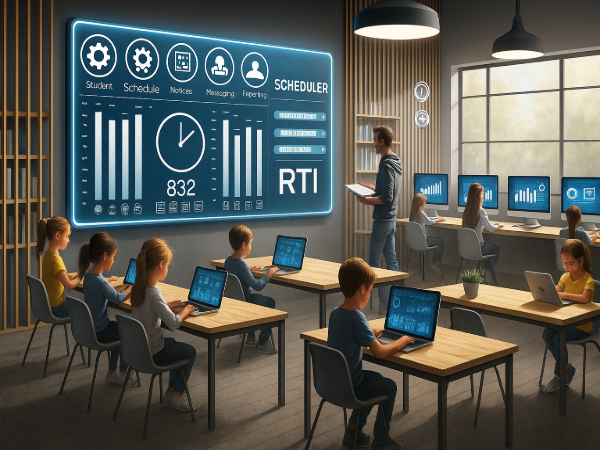RTI Scheduler: Transforming Student Support with Smarter Scheduling
Streamlining Intervention and Flex Time Programs for Modern Schools

RTI Scheduler is a powerful educational tool designed to simplify the complexities of student scheduling, particularly in schools implementing Response to Intervention (RTI) or Flex time programs. By automating and organizing intervention blocks, this software ensures that every student receives timely, personalized support while reducing the administrative burden on teachers and staff. It has become an indispensable solution for schools striving to balance academic interventions, enrichment opportunities, and efficient classroom management.
Introduction to RTI Scheduler
In today’s evolving educational environment, schools face the challenge of meeting diverse student needs while ensuring that no learner is left behind. Teachers must manage students requiring additional help, advanced learners seeking enrichment, and large groups needing flexible scheduling. Traditionally, these tasks were handled manually, which often led to errors, scheduling conflicts, and lost instructional time.
This is where the RTI Scheduler steps in. It is more than just a digital calendar—it’s a comprehensive scheduling solution that organizes intervention sessions, manages resources, prevents conflicts, and tracks attendance. Schools adopting RTI Scheduler experience smoother operations, improved student outcomes, and a more data-driven approach to personalized learning.
What is RTI Scheduler?
The RTI Scheduler is an educational software platform built to support schools running Response to Intervention (RTI) or Multi-Tiered Systems of Support (MTSS) programs. It allows administrators and teachers to:
Create flexible schedules for intervention or enrichment blocks.
Automatically assign students to appropriate sessions.
Track participation and attendance seamlessly.
Adjust schedules dynamically without disrupting core instructional time.
In simple terms, RTI Scheduler is the engine that powers personalized learning logistics. It ensures that every student receives the right support at the right time.
Why Schools Need RTI Scheduler
Increasing Complexity in Student Needs
Every classroom contains a mix of learners: some struggle with concepts, others grasp them quickly, and some require specialized attention. Without an organized system, balancing these needs becomes chaotic.
The Limits of Manual Scheduling
Paper-based scheduling or spreadsheets often cause double bookings, overlooked students, and excessive workload for staff. As class sizes grow and programs expand, manual methods simply cannot keep up.
The Demand for Personalized Learning
Modern education emphasizes personalization. Students are no longer expected to fit into one mold—schools must adapt to their unique needs. RTI Scheduler makes personalization operationally possible.
Key Features of RTI Scheduler
Flexible Scheduling
Teachers and administrators can create daily, weekly, or monthly intervention schedules that adapt to students’ evolving needs.
Conflict Prevention
The system detects scheduling conflicts automatically, ensuring that no student is double-booked or missed.
Student Self-Enrollment
Some versions allow students to sign up for enrichment sessions or tutoring opportunities themselves, giving them agency over their learning.
Customizable Session Parameters
Educators can set details such as maximum capacity, location, grade level, subject, and teacher assignments.
Attendance Tracking
RTI Scheduler records which students attend sessions, making it easier to analyze participation and accountability.
Data Integration
The tool often integrates with Student Information Systems (SIS) to pull accurate student data, ensuring seamless updates.
Real-Time Notifications
Students and teachers receive updates instantly, reducing confusion and miscommunication.
Benefits of Using RTI Scheduler
Saves Time for Teachers and Administrators
By automating scheduling, RTI Scheduler reduces the hours staff spend juggling intervention blocks manually.
Improves Student Outcomes
Students receive timely support, leading to better academic results, improved confidence, and reduced learning gaps.
Encourages Student Engagement
With self-enrollment and customizable sessions, students take more responsibility for their own learning.
Promotes Accountability
Attendance and participation data provide measurable evidence of program effectiveness.
Optimizes Resources
From classroom space to teacher availability, RTI Scheduler ensures resources are allocated efficiently.
RTI Scheduler in the Response to Intervention Framework
Response to Intervention (RTI) is a tiered model designed to identify and support struggling students. It has three levels:
Tier 1 – Universal classroom instruction for all students.
Tier 2 – Targeted small-group interventions for students who need extra help.
Tier 3 – Intensive one-on-one interventions for high-need learners.
RTI Scheduler plays a crucial role in managing these tiers by organizing when and where interventions take place, which teacher leads them, and how students rotate between levels. Without an efficient scheduling system, the RTI model can quickly become overwhelming.
How RTI Scheduler Supports Flex Time Programs
Many schools now implement Flex Time programs—dedicated blocks of the school day where students choose or are assigned to academic supports or enrichment activities. Flex Time allows struggling learners to receive tutoring while advanced learners explore enrichment opportunities like STEM labs, arts, or leadership sessions.
RTI Scheduler makes Flex Time possible by:
Coordinating multiple sessions at once.
Allowing students to choose activities while preventing conflicts.
Ensuring teachers have balanced group sizes.
This flexibility transforms the school day into a more student-centered experience.
Real-World Examples of RTI Scheduler in Action
A middle school using RTI Scheduler reported that student intervention attendance improved by 40% once scheduling became automated.
Teachers in a high school noted a significant reduction in workload, as they no longer had to manually track attendance for intervention blocks.
Administrators observed more effective use of classroom spaces, as the system balanced room capacities automatically.
These real-world results highlight the practical benefits of moving from manual systems to digital scheduling.
Challenges Without RTI Scheduler
Schools that avoid scheduling software often struggle with:
Missed intervention opportunities.
Confusion among students about where to go during intervention blocks.
Teachers overloaded with manual scheduling responsibilities.
Unequal access to support or enrichment programs.
By contrast, RTI Scheduler eliminates these obstacles and ensures a smoother flow of operations.
Future of RTI Scheduler in Education
As education becomes more data-driven, tools like RTI Scheduler will continue to evolve. Future improvements may include:
AI-powered scheduling that predicts student needs based on performance.
Deeper integration with digital learning platforms.
Mobile-friendly apps to keep students and parents informed.
Advanced analytics dashboards for administrators to evaluate interventions.
This future vision ensures that RTI Scheduler will remain a cornerstone in modern educational practices.
Tips for Successful Implementation
Train Staff Thoroughly – Teachers and administrators must understand all features for maximum benefit.
Communicate with Students – Explain how scheduling works to avoid confusion during intervention blocks.
Leverage Data – Use attendance and participation reports to refine intervention strategies.
Start Small – Begin with one grade level or department before expanding school-wide.
These steps make adoption smoother and maximize long-term success.
Conclusion
The RTI Scheduler is not just a scheduling tool—it is a strategic solution that supports personalized learning, boosts student outcomes, and simplifies daily operations for educators. As schools continue to adapt to the evolving educational landscape, tools like RTI Scheduler will play a vital role in ensuring every student receives the right support at the right time.
By automating intervention and Flex Time programs, schools can shift focus from administrative struggles to what truly matters—student growth and achievement.



